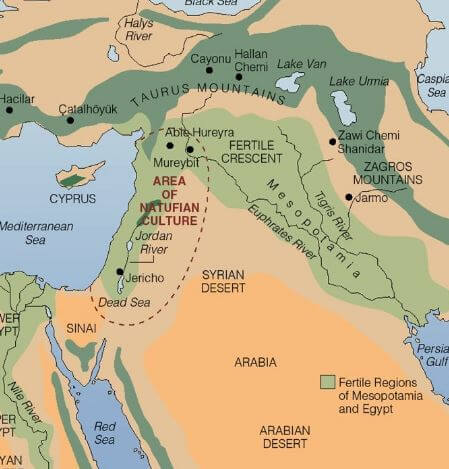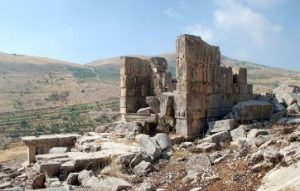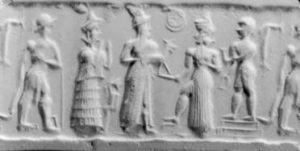Mesopotamia means “between rivers” in Greek. The region thus denominated initially included the territories comprehended between the Tigris and Euphrates rivers. In the present, it includes Iraq and eastern Syria.
Ancient Mesopotamia
Contents

Introduction
The abundance of water created a great natural richness, to such a point that, according to the Bible, Paradise was located there. The neolithic quickly reached a great level of development in Mesopotamia, with important urban settlements like Eridu or Uruk (from the year 3750 B.C.).
It was very likely in this city where a complex system of writing began. The history of Mesopotamia is a succession of civilizations, initiated by the Sumerians (3000 B.C. – 2350 B.C.). These were defeated by the armies of Sargon, king of the Akkadians (Akkad), who imposed his power until 1800 B.C.
From this time two important cultures coexisted: the Assyrians (Assur) to the north, and the Babylonians (Babylon) to the south. Each one evolved in a different way, but both ended up being dominated by warrior nations who arrived from the east, the Persians (Persia), Medes, and Achaemenids.
Speaking of Mesopotamia means discovering many cultures, kings, city-states, and wars, such as:
The first settlements were Umm, Eridu, and El Obeid. During the 4th and 3rd millennia before Christ the Sumerians and Akkadians developed their civilization in Mesopotamia.
Centuries later the Assyrian Empire was one of the most fascinating empires in ancient history.
The apogee of Mesopotamia did not remain only with the Assyrian or Babylonian empires. During the Arab epoch, Mesopotamia was the seat of the Caliphate, although from then on it began to decline.

The culture just as much as the technical advances which the peoples of Mesopotamia developed have transcended and influenced western European culture in the present and are the origin of our way of thinking and living:
- The wheel.
- The first cities.
- The use of natural resources.
- Mathematics.
- Writing.
Timeline of Ancient Mesopotamia
Evolution from Prehistory to the Persian conquest of the Chaldean Empire.
- (10000 B.C. / 8000 B.C ) This is the era of the Natufian Culture which extended from the Euphrates to Egypt.
- (8000 B.C.) The Neolithic begins to show itself in Mesopotamia with the first evidence of agriculture and livestock.
- (6000 and 5000 B.C.) Livestock and agriculture are totally consolidated in Mesopotamia and the first cities appeared. It is the epoch of the Umm culture, and of the Hassuna, Samarra, and Halaf cultures.
- (5000 and 3700 B.C.) The culture of Eridu develops during these years and gives rise to the period of El Obeid.
- (3500 B.C / 2800 B.C.) Uruk ascends, denominating this time as the Uruk Period. The wheel was invented and around 3300 B.C. cuneiform writing began to be used. It gave rise to History in the region of Ancient Mesopotamia, while the rest of the planet continued in Prehistory. The culture of the Sumerians can already be distinguished, with city-states like Uruk or Ur.
- (2800 B.C.) The Sumerian, and already historic, Period begins, denominated the Archaic Dynasty with the development and splendor of the Sumerian cities in the south of Mesopotamia.
- (2350 B.C.) The Akkadian Empire begins.
- (2100 B.C.) The resurgence of the Sumerians.
- (2000 B.C.) The peak of the Amorites.
- (1792 B.C.) Hammurabi takes power in Babylonia and commences its expansion through Mesopotamia and the surrounding areas.
- (1595 B.C.) Babylonia was conquered by the Hittites.
- (1360 B.C.) The peak of the Assyrian Empire.
- (612 B.C.) Babylonia conquers Nineveh, capital of the Assyrian Empire. The empire denominated the Chaldean Empire begins.
- (538 B.C.) Persia with Cyrus II the Great at its head conquers Babylon and puts an end to the Chaldean Empire.
Ancient Mesopotamia: Cities
Babylon, Ur, and Uruk were the most important cities of Ancient Mesopotamia. Some other cities of Ancient Mesopotamia were:
- Babylon
- Ur
- Uruk
- Sippar
- Akshak
- Kish
- Marad
- Isin
- Nippur
- Adab
- Zabalan
- Shuruppak
- Umma
- Girsu
- Lagash
- Nina
- Bab-Tibira
- Larsa
- Eridu
Sumerian Cities
Around the fourth millennium B.C. in Ancient Mesopotamia the transition of neolithic settlements to the apparition of the first cities in history occurred. The cities began to be the primary center of activity and their inhabitants began an intense specialization of work, such that each person only knew how to carry out one activity.
In Mesopotamia, the cities settled themselves in the context of the two great rivers, the Tigris and the Euphrates. Crops were created with irrigation canals, and there were small villages around each great city.
The cities were frequently rivals among themselves, and they were separated by a no-man’s-land, steppe-like, semiarid, marshy, or desert-like, which was taken advantage of by the nomadic peoples for shepherding.

Life in the Sumerian cities
The life of the Sumerian cities revolved around the temple, as it dominated the politics, the economy, and of course the religion of the city. The temple possessed lands and livestock, it traded and offered work in exchange for lands or salaries. The high priest was denominated “En” or “Lord” and was treated at the same time as the highest religious authority and the political leader of the city until in the third millennium B.C. this was substituted by “Ensi” or “Lugal” who held military power and who already had the characteristics of a king at his disposal. The Sumerian cities frequently made war for the dominion of cultivatable lands which made a new organization rise: the army. The distribution of work settled firmly in the appearance of four large social groups which lived in the cities: the artisans, the farmers, the priests, and the soldiers.
Ancient Mesopotamia: Religion
Religion in the Mesopotamian world dominated everything and remained more or less unchangeable until the Muslim conquest.
It was based in the beginning on the forces of nature, which are identified with the gods: the god of water was Enlil, that of the sky Anu, and that of the earth Enki. These gods little by little took on form, first with symbols, and ending up by having a human form. Anu would be the god of the gods.
Later on they went on forming new gods: the great goddess Inanna, who would later be identified with Ishtar, would be the most venerated goddess. She was the goddess of fertility and love. Sin would be the moon, and Shamash the sun. To these other gods would be added which would only be venerated in certain areas, like Assur in Assyria or Marduk in Babylonia.
In spite of being extremely important, religion in Mesopotamia did not have an artistic development as important as in Egypt. They also believed in maleficent spirits and demons, a belief which definitely would influence their art as there are numerous artistic representations to frighten these spirits as, among other things, they believed that they were related to sicknesses. Linked to religion there was a world which in Mesopotamia had a great boom: magic, especially that related to the observation of the stars, astrology, of which the Mesopotamian peoples would have great knowledge which they transmitted to other peoples.
The temples would be great complexes which went on developing through the distinct epochs and in them, a great bureaucracy arose. It was not only a religious institution, but also a political and administrative one. Thus, around the religious grounds would be constructed a series of estates and even the palace of the king. The monarch would be the one who was to construct the temples. Thus the king-priest laid the first stone of these constructions, which for the Mesopotamians was very important, because of which there are many representations of this act.
Ancient Mesopotamia: Society
The cities were bound together in various city-states which were autonomous and independent and which were governed by a monarch who led the army, administered justice, and led the religious rites along with the priests. He was the owner and lord of the whole territory.
There were two types of nobility: the courtesan nobility and the employed nobility, or rather those in the army or those in the administration. There were also scribes, although they were not as well represented as in Egypt, but they were also very well regarded and were linked to the temple. The urban class was formed by merchants and artisans. Below were situated the peasants and last of all the slaves. This society was well organized from the beginning. One proof of this is the legislation which existed from very early on, like that of Ur-Namu, which is the oldest, from the Neo-Sumerian era, or the code of Hammurabi, from the Babylonian era.

This development of the peoples has been able to be studied thanks to their knowledge of writing. It was known since the end of the 4th millennium, with the Sumerians. It was a cuneiform script, thus called because of the appearance of the strokes, which are in the shape of a wedge. The writing has appeared on tablets of soft clay and was made with a chisel or a reed pen, with which they made the strokes, after which the tablets were cooked so that they would harden. The first tablets were functional, written on bricks in the foundations of temples, and later it appeared in relieves, on hard materials, etc.
The cuneiform script has been known since 1802 thanks to Groterfend, who deciphered the Persian stele of Behistun, which was written in three languages: Persian, Akkadian, and Elamite. It is known that libraries existed, but they have disappeared. The most important was that of Nineveh.
The Mesopotamian people were very developed and possessed of great culture. They were the great discoverers of astrology: they know planets, movements, constellations, they invented the horoscope, etc.
They also had great knowledge of medicine and surgery, of which notes remain, for example, in the code of Hammurabi.
They were outstanding in mathematical calculations and in mercantile operations. They also had great texts related to the world of literature: there are remains of epic poems, orations, didactic texts, etc., but always with a practical purpose, which was the continual exaltation of those in power, a continual political and religious character. The plastic arts also had this objective, no aesthetic motivation existed, because of which the names of artists are not known, as they only served to exalt the powers in place with a propagandist aspect.
